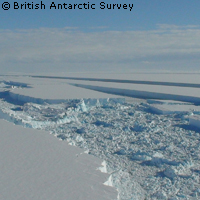Antarctic ice shelf breaking away
Scientists are observing a massive change in Antarctica that could see the maps of the region redrawn; the Wilkins Ice Shelf appears to be ready to break away from the Antarctic. The Wilkins Ice Shelf is now supported only by a thin strip of ice hanging between two islands. According to scientists this is an identifiable impact of climate change on the Antarctic environment. Back in the early 1990s, many scientists, including Professor David Vaughan of the British Antarctic Survey (BAS), predicted that the northern part of the Wilkins Ice Shelf could be lost by 2020 if climate warming in the region were to continue at the same rate. Current data however is proving these estimates to be optimistic. '(The) Wilkins Ice Shelf is the most recent in a long, and growing, list of ice shelves on the Antarctic Peninsula that are responding to the rapid warming that has occurred in this area over the last fifty years,' commented Professor Vaughan. 'Current events are showing that we were being too conservative, when we made the prediction in the early 1990s that Wilkins Ice Shelf would be lost within thirty years - the truth is it is going more quickly than we guessed.' As the ice shelf disintegrates, it puts increasing pressure on the ice bridge connecting the shelf to Charcot Island. Once the bridge collapses, the remainder of the ice shelf will be put at risk. Scientists traditionally track changes in the stability of ice shelves as they usually hold back glaciers. Without ice shelves holding back glaciers, glaciers collapse which in turn raises sea levels. However such fears may not be warranted in this particular case. 'The Wilkins disintegration won't raise sea level because it already floats in the ocean, and few glaciers flow into it,' said glaciologist Ted Scambos of the National Snow and Ice Data Center (NSIDC) in the US. 'However, the collapse underscores that the Wilkins region has experienced an intense melt season. Regional sea ice has all but vanished, leaving the ice shelf exposed to the action of waves,' he continued. The impending disintegration was first witnessed using satellite imagery. This motivated the British Antarctic Survey to launch a fly over of the crumbling ice shelf to collect video footage and make detailed observations up close. Special planes were used in this mission. The de Havilland Canada DHC-6 Twin Otter are commonly used for missions in extremely cold situations as they are able to fly in temperatures as low as -75°C. What scientists saw on both the satellite images and up close observations is not heartening. Last February the scientists observed an area of approximately 400 square kilometres break off from the Wilkins Ice Shelf, narrowing the ice bridge that connects it to Charcot and Latady Islands down to a 6 km strip. From 30 to 31 May 2008 it experienced further break-up with an area of about 160 square kilometres breaking off, reducing the ice bridge to just 2.7 km. Based on these observations, the situation is dire and cannot be understated. 'Wilkins is the largest ice shelf on West Antarctica yet to be threatened. This shelf is hanging by a thread,' concluded Professor Vaughan.



